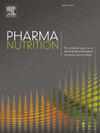Efficacy and safety of crocin supplementation in patients with central serous chorioretinopathy, a pilot randomized double blinded clinical trial
IF 2.4
Q3 NUTRITION & DIETETICS
引用次数: 0
Abstract
Background
Central Serous Chorioretinopathy (CSCR) is a vision-threatening condition characterized by serous retinal detachment. Crocin, a carotenoid compound found in saffron, has demonstrated antioxidant and anti-inflammatory properties in various retinal diseases, but its efficacy in CSCR remains understudied.
Methods
In this randomized controlled trial, 40 patients with CSCR were assigned to receive either crocin (n=20) or placebo (n=20) over an eight-weeks period. Visual acuity, anatomical outcomes measured by optical coherence tomography (OCT), and adverse events were assessed at baseline and at the end of the intervention period.
Results
There were no significant differences observed in age, weight, body mass index, or gender distribution between the two groups (p > 0.05 for all comparisons). The changes in mean ETDRS letter score were significantly more in crocin group compared to the placebo group (4.27±3.63 vs 0.57±7.23, respectively, p=0.024). In the crocin group, 20 %, 40 % and 80 % of patients showed an improvement of 10,5 and 1 ETDRS letters, compared to only 7 %, 21 % and 29 % in the placebo group (p=0.316, p=0.280, p=0.005, respectively). While the crocin group exhibited greater mean reductions in sub-retinal fluid height, central macular thickness, and choroidal thickness compared to the placebo group, these differences did not reach statistical significance (p > 0.05 for all comparisons). No adverse events associated with the trial intervention were reported by any patient in either the crocin or placebo group.
Conclusion
The findings of this pilot study suggest that crocin supplementation may lead to improvements in visual acuity in patients with CSCR. Differences in anatomical outcomes between crocin and placebo groups did not reach statistical significance in this pilot study.
中心性浆液性脉络膜视网膜病变患者补充巴豆苷的有效性和安全性--一项随机双盲临床试验
背景中心性浆液性脉络膜视网膜病变(CSCR)是一种以浆液性视网膜脱离为特征的威胁视力的疾病。藏红花中的类胡萝卜素化合物藏红花苷已在多种视网膜疾病中显示出抗氧化和抗炎特性,但其对 CSCR 的疗效仍未得到充分研究。在基线和干预期结束时,对视力、光学相干断层扫描(OCT)测量的解剖学结果和不良事件进行了评估。结果观察到两组患者在年龄、体重、体重指数或性别分布方面无显著差异(所有比较均为 0.05)。与安慰剂组相比,羊角霉素组平均 ETDRS 字母评分的变化明显更大(分别为 4.27±3.63 vs 0.57±7.23,P=0.024)。在巴豆苷组中,20%、40% 和 80% 的患者的 ETDRS 分值分别提高了 10、5 和 1 个字母,而安慰剂组仅有 7%、21% 和 29% 的患者的 ETDRS 分值分别提高了 10、5 和 1 个字母(P=0.316、P=0.280、P=0.005)。与安慰剂组相比,曲安奈德组视网膜下积液高度、黄斑中心厚度和脉络膜厚度的平均降低幅度更大,但这些差异未达到统计学意义(所有比较的 p 均为 0.05)。结论这项试验性研究的结果表明,补充巴豆苷可改善 CSCR 患者的视力。在这项试点研究中,巴豆苷组和安慰剂组在解剖结果上的差异未达到统计学意义。
本文章由计算机程序翻译,如有差异,请以英文原文为准。
求助全文
约1分钟内获得全文
求助全文
来源期刊

PharmaNutrition
Agricultural and Biological Sciences-Food Science
CiteScore
5.70
自引率
3.10%
发文量
33
审稿时长
12 days
 求助内容:
求助内容: 应助结果提醒方式:
应助结果提醒方式:


